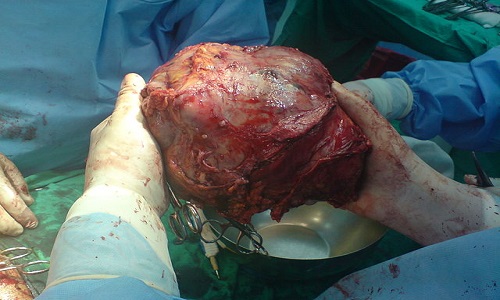Difference Between Tumors and Polyps
The word “tumor” is derived from the Latin word for “swelling,” which indicates swelling of any body parts. Swelling indicates one of the cardinal signs of inflammation. Hence, tumor refers to a solid or fluid-filled cystic lesion, which might or might not have formed due to an abnormal growth of neoplastic cells. Tumors are also referred to as those neoplasms that often form an abnormal mass of tissue. The term “tumor” is often associated with the words “mass” and “nodules.” The term “tumor” is often used generically without reference to the size of the swelling or mass. However, the term “mass” indicates a cystic lesion that has a maximum diameter of at least 20 mm. On the other hand, the “nodule” indicates a cystic lesion whose size is more than 20 mm.[1]
Tumors can be broadly classified into three types:
- Benign Tumors – they are circumscribed and localized and do not form cancer;
- Premalignant Tumors – these tumors are localized and normally do not invade the neighboring tissues but may become malignant upon exposure to suitable signals;
- Malignant Tumor – these tumors invade foreign tissues and destroy them by a process called metastasis and are cancerous.
Tumor formation is based on the theory of continuum mechanisms. It has been established that the growth of a tumor always occurs on its outer edges, and the stiffening of the neighboring tissues prevents the growth of the tumor in most of the cases. Uterine fibroids and skin moles are examples of benign tumors. Discrete, localized enlargements of normal structures due to narrowing or obstruction can also exhibit as tumors. Encapsulated hematomas, discrete necrotic tissue due to an insect bite, and overgrowth of skin tissues that are associated with swelling are marked as ‘’tumors.” Localized reactions like swelling or inflammation due to antigen-antibody reactions are the basis of benign tumors. On the other hand, DNA damage either directly or indirectly by the Reactive Oxygen Species generated in the body leads to mutation of bases in the DNA and can cause premalignant or malignant tumors.[1]
Polyps represent abnormal growth of tissues projecting from mucous membranes. They can vary in size and appearance and look like a wart when small in shape; and upon growth, they appear like a cherry on a stem or a fig. Polyps can cause heavy bleeding, which may lead to anemia. When they look like a cherry on a stem or a fig, they are called “pedunculated polyps”; while if they lack the stem and just appear from mucous membranes, they are called “sessile polyps.” Polyps are commonly found in the colon, nasal mucosa, stomach, and the urinary bladder. Thus, polyps can be broadly classified as digestive, colorectal, cervical, nasal, and urinary polyps.[2,3]
Digestive polyps can be further subdivided into:
- Hyperplastic polyps: appear as serrated, un-branched crypts with no risk of malignancy;
- Sessile serrated adenomas: appear as serrated, branched crypts with risk of malignancy;
- Inflammatory adenomas: appear as an inflammation of the mucosa or submucosa, and if dysplasia persists, risk of malignancy increases;
- Tubular adenomas: tubular glands appear to consist of elongated nuclei, and risk of malignancy exists;
- Traditional serrated adenomas: serrated crypts with villi-like appearance and carries risk of malignancy;
- Fibroid polyps: spindle cells with concentric arrangement of spindle cells around blood vessels causing inflammation and release of eosinophils with no risk of malignancy.
Colorectal polyps: found in the colon and rectum and with a size less than 2.5 cm; do not lead to the risk of malignancy. They can be classified as malignant, hyperplastic, and inflammatory. Malignant polyps are adenomatous and grow in the lining of the stomach with no risk of malignancy.
Nasal polyps: polypoid masses that grow in the mucous membrane of the nose and paranasal sinuses.
Cervical polyp: grows as a benign polyp in the wall of the cervix and may lead to irregular menstrual bleeding.
Endometrial polyp: grows as a sessile polyp or lesion in the uterine wall; and if pedunculated, protrudes into the cervix with its origin as uterus. [2, 3]
Comparison of Tumors and Polyps Represented Below[2,3]
|
Attribute |
Polyps |
Tumors |
| Physical appearance | Can be sessile or pedunculated | Does not appear pedunculated |
| Bleeding features | Associated with bleeding & anemia | Is not associated with bleeding & anemia |
| Size and shape | Wide variation in size and appearance | Size and appearance does not vary much |
| Malignancy risk | Malignancy risk low, present only in adenomatous polyps | Malignancy risk high |
| Origin | Always have a mucosal or submucosal origin | Not localized to mucosa or submucosa |
| Classification | Extensively classified | Narrow classification – mainly benign or malignant |
| Involvement of blood vessels | Yes | Not always |
- Difference Between “Heart attack” and “Cardiac arrest” - June 24, 2016
- Difference Between Connective Tissue and Epithelial Tissue - June 22, 2016
- Difference Between Migraine And Stroke - January 11, 2016
Search DifferenceBetween.net :
Leave a Response
References :
[0]Ambrosi D, Mollica F (2002). "On the mechanics of a growing tumor". International Journal of Engineering Science 40 (12): 1297–316.
[1]Fletcher's Diagnostic Histopathology of Tumors, Third Edition.
[2]Sternberg's Diagnostic Surgical Pathology, Fifth Edition
[3]https://en.wikipedia.org/wiki/Liver_tumor

